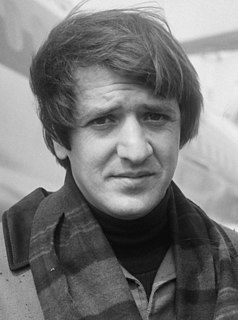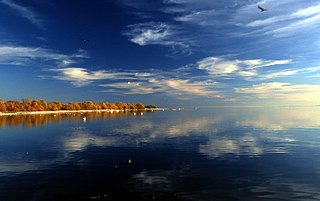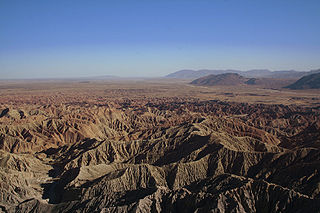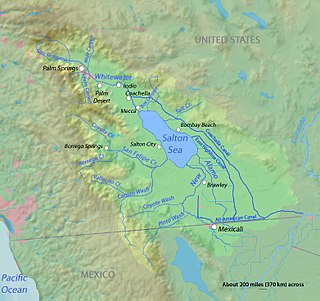
Salvatore Phillip "Sonny" Bono was an American singer-songwriter, producer, actor, and politician who came to fame in partnership with his second wife Cher as the popular singing duo Sonny & Cher. He was mayor of Palm Springs, California from 1988 to 1992, and the Republican congressman for California's 44th district, elected during the Republican Revolution and serving from 1995 until his death in 1998.

Bombay Beach is a census-designated place (CDP) in Imperial County, California, United States. It is located on the Salton Sea, 4 miles (6.4 km) west-southwest of Frink and is the lowest community in the United States, located 223 feet (68 m) below sea level. The population was 295 at the 2010 census, down from 366 in 2000. The population estimate for 2020 was 415. It is part of the El Centro, California, metropolitan statistical area.

Salton City is a census-designated place (CDP) in Imperial County, California. It is the largest Imperial County development on the Salton Sea coast. It is part of the El Centro, California Metropolitan Statistical Area. The population was 3,763 at the 2010 census, up from 978 in 2000. The population estimate for 2020 was 5,611.

Mecca is an unincorporated community located in Riverside County, California, United States. The desert community lies on the North shore of the Salton Sea in the eastern Coachella Valley and is surrounded by agricultural land.

Salton Sea Beach is a census-designated place (CDP) in Imperial County, California, located 2.5 miles (4 km) southeast of Desert Shores. The population was 422 at the 2010 census, up from 392 at the 2000 census. It is part of the El Centro, California Metropolitan Statistical Area. It was the location of the Naval Auxiliary Air Station Salton Sea.

The Great Basin is the largest area of contiguous endorheic watersheds in North America. It spans nearly all of Nevada, much of Oregon and Utah, and portions of California, Idaho, Wyoming, and Baja California, Mexico. It is noted for both its arid climate and the basin and range topography that varies from the North American low point at Badwater Basin in Death Valley to the highest point of the contiguous United States, less than 100 miles (160 km) away at the summit of Mount Whitney. The region spans several physiographic divisions, biomes, ecoregions, and deserts.

The Salton Sea is a shallow, landlocked body of water that has a high concentration of salts in Riverside and Imperial counties. Located on the San Andreas Fault at the southern end of the U.S. state of California, it lies within the Salton Trough that stretches to the Gulf of California in Mexico. Over millions of years, the Colorado River has flowed into the Imperial Valley and deposited alluvium (soil) creating fertile farmland, building up the terrain and constantly moving its main river delta. For thousands of years, the river has alternately flowed into and out of the valley, alternately creating a freshwater lake, an increasingly saline lake, and a dry desert basin, depending on river flows and the balance between inflow and evaporative loss. Hundreds of archaeological sites have been found, indicating possibly long-term Native American villages and temporary camps.

The Imperial Valley lies in the California counties of Imperial and Riverside in southeastern Southern California with an urban area centered on the city of El Centro. The Valley is bordered by the Colorado River to the east and, in part, the Salton Sea to the west. Farther west lies the San Diego and Imperial County border. To the north is the Coachella Valley region of Riverside County, which together with Imperial Valley form the Salton Trough, or the Cahuilla Basin, also the county line of Imperial and Riverside counties, and to the south the international boundary with the U.S. state of California and Baja California.

Anza-Borrego Desert State Park (ABDSP) is a California State Park located within the Colorado Desert of southern California, United States. The park takes its name from 18th century Spanish explorer Juan Bautista de Anza and borrego, a Spanish word for sheep. With 585,930 acres (237,120 ha) that includes one-fifth of San Diego County, it is the largest state park in California.

California's Colorado Desert is a part of the larger Sonoran Desert. It encompasses approximately 7 million acres, including the heavily irrigated Coachella and Imperial valleys. It is home to many unique flora and fauna.

The Salton Sea State Recreation Area offers hunting, fishing, swimming, and camping to visitors on the northeastern side of the Salton Sea.

The Salton Sink is the low point of an Endorheic basin, a closed drainage system with no outflows to other bodies of water, in the Colorado Desert sub region of the Sonoran Desert. The sink falls within the larger Salton Trough and separates the Coachella Valley from the Imperial Valley, which are also segments of the Salton Trough. The lowest point of the sink is 269 ft (82 m) below sea level, and since 1906 the 343 square miles (890 km2) Salton Sea has filled the lowest portion of the sink to a water depth of up to 43 ft (13 m).
The California Development Company was formed in 1896 as a replacement for the defunct Colorado River Irrigation Company, which had been started a few years earlier for the purpose of planning an irrigation system for the lower Colorado Desert in California. The rich, silty soil of the area was found to be suitable for agriculture, but wells tapping groundwater brought up an inadequate supply of water for such a hot, arid region. The California Development Company took over the project of diverting Colorado River water into the Coachella and Imperial Valleys in the Salton Sink, a dry lake bed which today contains the Salton Sea, hoping to turn the desert green with agricultural fields. The first canals were being constructed by 1900 under the guidance of chief engineer George Chaffey.
M. Penn Phillips, born Marion Phillips, was an American entrepreneur and prominent real estate developer, born in Parsons, Kansas.
The Lost Ship of the Desert is the subject of legends about various historical maritime vessels having supposedly become stranded and subsequently lost in the deserts of the American Southwest, most commonly in California's Colorado Desert. Since the period following the American Civil War, stories about Spanish treasure galleons buried beneath the desert sands north of the Gulf of California have emerged as popular legends in American folklore.
Plagues & Pleasures on the Salton Sea is a documentary film by Chris Metzler and Jeff Springer, with narration by John Waters and music by Friends of Dean Martinez.

The Winning of Barbara Worth is a 1926 American Western silent film directed by Henry King, and starring Ronald Colman, Vilma Bánky and Gary Cooper. Based on Harold Bell Wright's novel The Winning of Barbara Worth, the film is remembered for the climactic flood sequence, depicting the 1905 formation of the Salton Sea.

The Sonny Bono Salton Sea National Wildlife Refuge is at the southern end of the Salton Sea in Imperial Valley, California, 40 miles (64 km) north of the Mexican border. Situated along the Pacific Flyway, the Refuge is the only one of its kind, located 227 feet (69 m) below sea level. Because of its southern latitude, elevation and location in the Colorado Desert, the Refuge experiences some of the highest temperatures in the nation. Daily temperatures from May to October generally exceed 100 °F with temperatures of 116°–120 °F recorded yearly.












